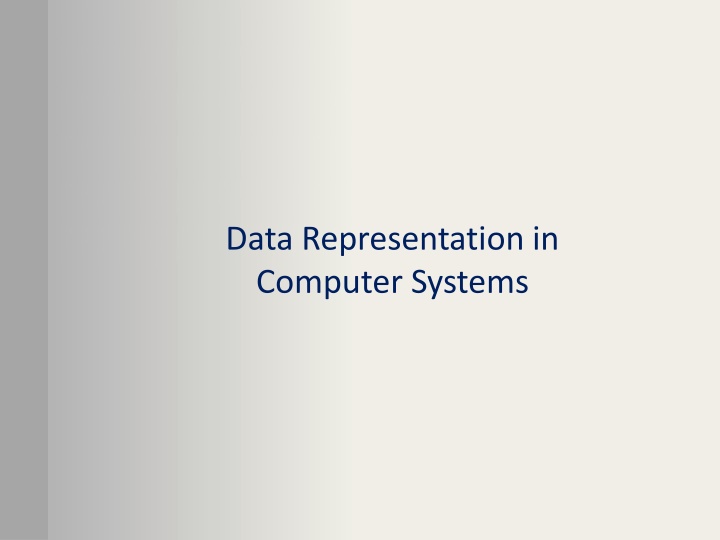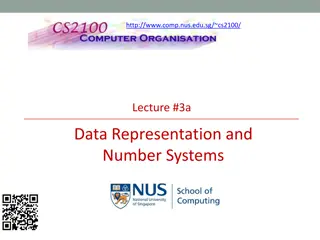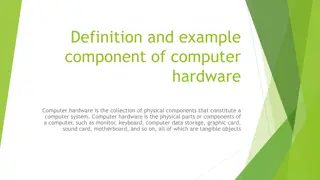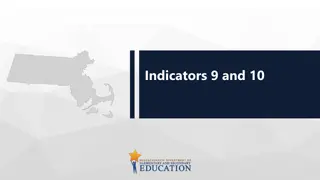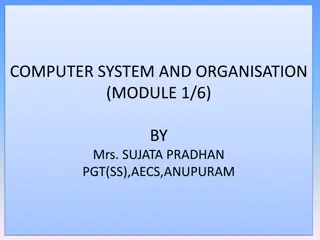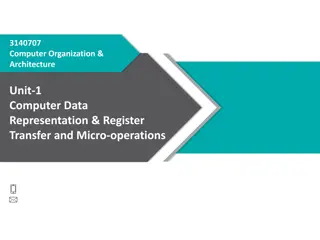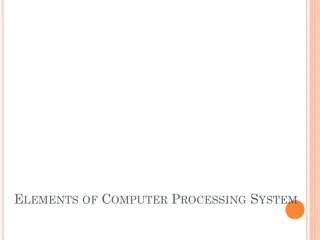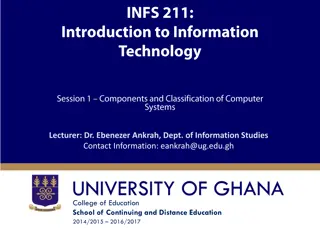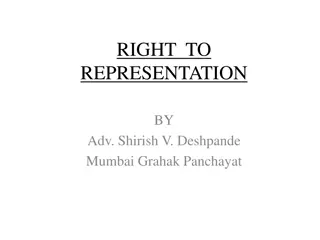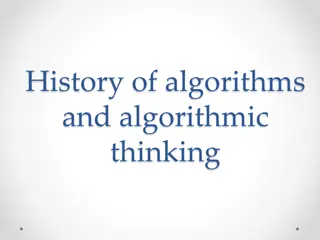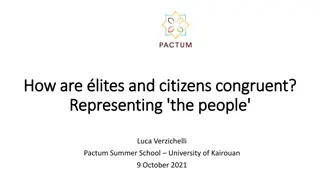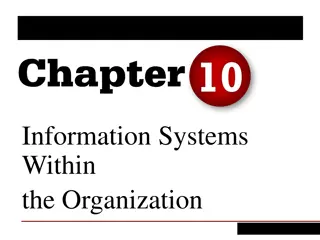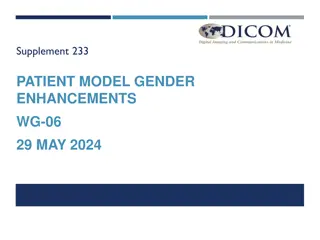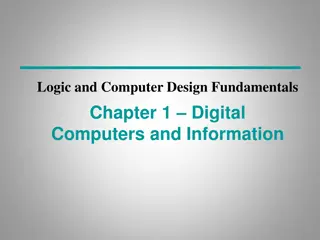Data Representation in Computer Systems
In this data representation exploration, we delve into positional numbering systems, binary to decimal conversion, and signed integer representations. The material covers the significance of radices like binary, octal, and hexadecimal in computer science. It also illustrates how numeric values are represented through powers of a given radix. The content further explores converting unsigned integer numbers, fractions, and the process of converting between power-of-two radices. Through visuals and explanations, this resource aims to enhance understanding of data representation in computer systems.
Download Presentation

Please find below an Image/Link to download the presentation.
The content on the website is provided AS IS for your information and personal use only. It may not be sold, licensed, or shared on other websites without obtaining consent from the author.If you encounter any issues during the download, it is possible that the publisher has removed the file from their server.
You are allowed to download the files provided on this website for personal or commercial use, subject to the condition that they are used lawfully. All files are the property of their respective owners.
The content on the website is provided AS IS for your information and personal use only. It may not be sold, licensed, or shared on other websites without obtaining consent from the author.
E N D
Presentation Transcript
Data Representation in Computer Systems
Lecture Overview Positional Numbering System Decimal to binary conversion Signed integer representation 2
Positional Numbering System The most important radices (bases) in computer science are: Binary - Radix 2 or base 2 - Numerals: {0 , 1} Octal - Radix 8 or Base 8 - Numerals: {0 , 1 , 2 , 3 , 4 , 5 , 6 , 7} Hexadecimal - Radix 16 or base 16 - Numerals: {0 , 1 , 2 , 3 , 4 , 5 , 6 , 7 , 8 , 9 , A , B , C , D , E , F} 3
Positional Numbering System Positional Numbering System ..cont Any numeric value is represented through increasing powers of a radix (or base) Examples 243.5110= 2x102+ 4x101+ 3x100+ 5x10-1+ 1x10-2 10110.012= 1x24+ 0x23+ 1x22+ 1x21+ 0x20+ 0x2-1+ 1x2-2= 22.2510 4
Lecture Overview Introduction Positional Numbering System Decimal to binary conversion Signed integer representation 5
Decimal to binary conversion Decimal Binary - HexaDecimal Keep in mind the following tables or how to obtain them! 6
Converting Unsigned Integer Numbers Division-remainder 2 |113 2 |56 2 |28 2 |14 2 |7 2 |3 2 |1 0 Remainder 1 Remainder 0 Remainder 0 Remainder 0 Remainder 1 Remainder 1 Remainder 1 LSB 11310 = 11100012 MSB 7
Lecture Overview Introduction Positional Numbering System Decimal to binary conversion Converting Unsigned Whole Numbers Converting fractions Converting between Power-of-Two Radices Signed integer representation 8
Converting fractions To convert fractions from decimal to any other base system we repeatedly multiply by the destination radix Example: Convert 0.430410 to base 5. 0.4304 x 5 2.1520 The integer part is 2 0.1520 x 5 0.7600 The integer part is 0 x 5 3.8000 The integer part is 3 0.8000 x 5 4.0000 The integer part is 4, the fractional part is zero, we are done 0.430410 = 0.20345 9
Converting fractions Example: Convert 0.3437510 to binary with 4 bits to the right of the binary point. 0.34375 x 2 0.68750 x 2 1.37500 0.37500 x 2 0.75000 x 2 1.50000 This is our fourth bit. We will stop here. 0.3437510 = 0.01012 10
Converting fractions Convert 26.78125 to binary: Example 1:26.7812510 = By using the methods just described we will have: 2610=110102 and 0.7812510=0.110012 So 26.7812510=11010.110012 Example 2: 0.01012=0x2-1+1x2-2+0x2-3+1x2-4 = 0 + 0.25 + 0 + 0.0625 = 0.312510 2 11
Converting between Power-of-Two Radices The most famous power-of-two radices are: binary (base 2) octal (base 23 / base 8) hexadecimal (base 24 / base 16). 12
Converting between Power-of-Two Radices Example: Convert 101100100111012 to octal Make Groups of 3 bits (from right to left): - 10 110 010 011 101 Add zero(s) on the left to complete the last octet - 010 110 010 011 101 Convert each octet to its corresponding octal digit - 010 110 010 011 101 2 6 2 3 5 Finally: 101100100111012 = 262358 13
Converting between Power-of-Two Radices Example: Convert 101100100111012 to hexadecimal Make Groups of 4 bits (from right to left): - 10 1100 10011101 Add zero(s) on the left to complete the last hextet - 0010 1100 10011101 Convert each hextet to its corresponding hexadecimal digit - 0010 1100 10011101 2 C 9 D Finally: 101100100111012 = 2C9D16 14
Lecture Overview Introduction Positional Numbering System Decimal to binary conversion Signed integer representation Signed Magnitude Complement system 15
Signed integer representation Two concepts are used Signed Magnitude concept Complement concept The MSB (Most Significant Bit) of a binary number is kept as the sign of the number MSB = 1: negative number MSB = 0: positive number The remaining bits represent the magnitude (or absolute value) of the numeric value 16
Signed Magnitude Example: In a 8 bit word signed magnitude system give the decimal representation of the following numbers 00000001? - The MSB is 0: The number is positive - The remaining 7 bits are: 00000012 = 110 - The decimal number is +1 10000001? - The MSB is 1: The number is negative - The remaining 7 bits are: 00000012 = 110 - The decimal number is -1 17
Signed Magnitude Example: In a 8 bit word signed magnitude system give the decimal representation of the following numbers 10001001? - The MSB is 1: The number is negative - The remaining 7 bits are: 00010012 = 910 - The decimal number is -9 01000001? - The MSB is 0: The number is positive - The remaining 7 bits are: 10000012 = 6510 - The decimal number is +65 18
Signed Magnitude In a N bit word signed magnitude system The largest integer is 2N-1 - 1 The smallest integer is -(2N-1 - 1) Example: in a 8 bit word signed magnitude system The largest integer is 011111112 = 27-1 = 12710 The smallest integer is 111111112 = -(27-1) = - 12710 19
Signed Magnitude Adding operands that have the same sign Example: Add 010011112 to 001000112 using signed-magnitude arithmetic. 1 1 1 1 carries 0 1 0 0 1 1 1 1 0 + 0 1 0 0 0 1 1 0 1 1 1 0 0 1 0 We find 010011112 + 001000112 = 011100102 in signed-magnitude representation. Sign + (35) (114) (79) 20
Signed Magnitude Overflow condition In the last example, adding the seventh bits to the left gives no carry If there is a carry, we say that we have an overflow condition and the carry is discarded, resulting in an incorrect sum. Example: Add 010000012 to 011000012 using signed-magnitude arithmetic 21
Signed Magnitude 1 carries 1 0 1 0 0 0 0 0 1 0 + 1 1 0 0 0 0 1 0 0 1 0 0 0 1 0 The addition overflows The last carry is discarded The sum s result is incorrect X + (97) (65) (34) 22
Signed Magnitude Signed-magnitude subtraction is carried out in a manner similar to pencil and paper decimal arithmetic Example 1: Subtract 010011112 (79) from 011000112 (99) using signed-magnitude arithmetic. 0 1 1 2 borrows 0 1 1 0 0 0 1 1 0 - 1 0 0 1 1 1 1 0 0 0 1 0 1 0 0 We find 011000112 - 010011112 = 000101002 in signed-magnitude representation. (99) (79) (20) 23
Signed Magnitude Problems related to signed magnitude To much decisions to make (larger number? ; borrows? ; what signs?). The number 0 could have two representations : 10000000 and 00000000. Complicated method Expensive circuits 24
Lecture Overview Introduction Positional Numbering System Decimal to binary conversion Signed integer representation Signed Magnitude Complement system Floating-point representation 25
Complement system Complement system is used to represent/convert negative numbers only When using complement system the subtraction is converted to an addition Advantages of complement system Simplify computer arithmetic No need to process sign bits separately The sign of a number is easily checked by looking at its high-order bit (MSB). 26
Complement system In a binary system r=2 The diminished radix complement is r-1 = 1 We say that we work in one s complement (C1) To convert a negative number to its one s complement this number is subtracted from all ones A positive number is directly converted to its binary representation Example: - The one s complement of 01012is 11112- 01012= 1010C1 - It is nothing more than switching all of the 1s with 0s and vice versa!! 27
Complement system Example: Express 2310 and -910 in 8-bit binary one s complement form. 2310 = + (000101112) = 00010111C1 -910 = - (000010012) = 11110110C1 28
Complement system In one s compliment the subtraction is converted into addition Example: 2310 910 = 2310 + (-910) Example: Add 2310 to -910 using 8-bit binary one s complement arithmetic. Carries: 1 1 1 1 1 1 0 0 0 1 0 1 1 1 2310 + 1 1 1 1 0 1 1 0 + (-910) 1410 0 0 0 0 1 1 0 1 The result is 00001110C1 = +(000011102)= 1410 29
Complement system Example: Add 910 to -2310 using 8-bit binary one s complement arithmetic. -2310 = - (00010111)2 = 11101000C1 910 = + (000010012) = 00001001C1 910 + (-2310) = 11101000C1 + 00001001C1 Carries: 0 0 0 0 1 0 0 0 910 0 0 0 0 1 0 0 1 + (-2310) + 1 1 1 0 1 0 0 0 -1410 1 1 1 1 0 0 0 1 Result: 11110001C1 = -(000011102) = -1410 30
Complement system In a binary system r=2 The diminished radix r = 2 We say that we work in two s complement To convert a negative number N to its two s complement, It is nothing more than one s complement incremented by 1. A positive number is directly converted to its binary representation 31
Complement system Example: In a 4 bits system: d=4; All negative numbers are converted by being subtracted from 2d = 24 = 1610 = 100002 The two s complement of 00112is 100002- 00112 = 1101C2 Or It is nothing more than one s complement incremented by 1!! 32
Complement system Example: Express 2310, -2310, and -910 in 8-bit binary two s complement form. 2310 = + (000101112) = 000101112 -2310 = -(000101112) = (111010002 + 1)C2 = 11101001C2 -910 = -(000010012) = (111101102 + 1)C2 = 11110111C2 33
Complement system Unlike C1 arithmetic, in C2 the last carry is discarded Example 1: Add 910 to -2310using two s complement arithmetic. Carries: 0 0 0 0 1 0 0 1 910 0 0 0 0 1 0 0 1 + (-2310) + 1 1 1 0 1 0 0 1 -1410 1 1 1 1 0 0 1 0 The result is 11110010C2 = -(000011102)= -1410 34
Complement system Note how a negative binary number in C2 is converted to decimal At first all 0 and 1 in the C2 s number are switched: 11110010 00001101 A 1 is then added to the last number: 00001101+1 = 00001110 So 11110010C2 = -(000011102)= -1410 35
Complement system Example 2: Find the sum of 2310 and -910 in binary using two s complement arithmetic. 2310 = +(00010111)2 = 00010111C2 -910 = -(000010012) = 11110111C2 2310 + (-910) = 00010111C2 + 11110111C2 Carries: 1 1 1 1 0 1 1 1 2310 0 0 0 1 0 1 1 1 + (-910) + 1 1 1 1 0 1 1 1 -1410 0 0 0 0 1 1 1 0 Result: 00001110C2 = +(000011102) = 1410 36
Complement system Advantages of two s complement It is the most popular choice for representing signed numbers The algorithm for adding and subtracting is quite easy It has the best representation for 0 (all 0 bits) It is self-inverting It is easily extended to larger numbers of bits. 37
